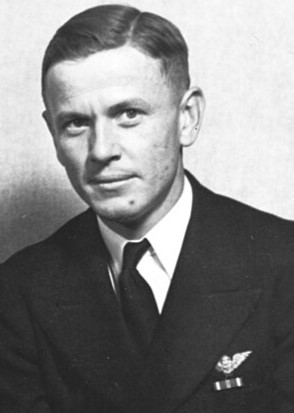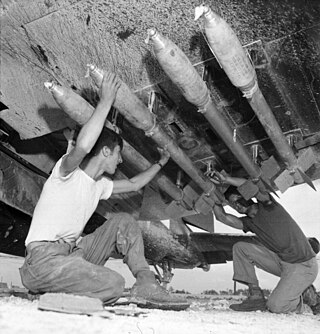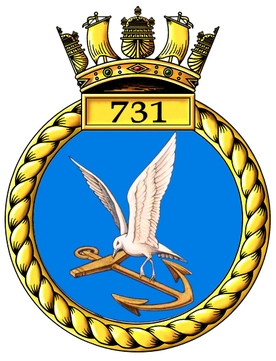
The Vought F4U Corsair is an American fighter aircraft which saw service primarily in World War II and the Korean War. Designed and initially manufactured by Chance Vought, the Corsair was soon in great demand; additional production contracts were given to Goodyear, whose Corsairs were designated FG, and Brewster, designated F3A.

A fighter-bomber is a fighter aircraft that has been modified, or used primarily, as a light bomber or attack aircraft. It differs from bomber and attack aircraft primarily in its origins, as a fighter that has been adapted into other roles, whereas bombers and attack aircraft are developed specifically for bombing and attack roles.

The Douglas SBD Dauntless is a World War II American naval scout plane and dive bomber that was manufactured by Douglas Aircraft from 1940 through 1944. The SBD was the United States Navy's main carrier-based scout/dive bomber from mid-1940 through mid-1944. The SBD was also flown by the United States Marine Corps, both from land air bases and aircraft carriers. The SBD is best remembered as the bomber that delivered the fatal blows to the Japanese carriers at the Battle of Midway in June 1942. The type earned its nickname "Slow But Deadly" during this period, along with a rarely-used accompanying nickname of "Furious D."

The Vought SB2U Vindicator is an American carrier-based dive bomber developed for the United States Navy in the 1930s, the first monoplane in this role. Vindicators still remained in service at the time of the Battle of Midway, but by 1943, all had been withdrawn to training units. It was known as the Chesapeake in Royal Navy service.

No. 25 Squadron of the Royal New Zealand Air Force was formed at Seagrove, Auckland in July 1943 with Douglas SBD Dauntless dive bombers and served in the Southern Pacific based at the Piva Airstrip on Bougainville, flying missions against Japanese forces on Bougainville and at Rabaul. It was disbanded in May 1944 and reformed as a fighter/ground attack squadron flying F4U Corsairs. It served in Santo, Guadalcanal, Los Negros and Emirau, before returning to New Zealand and being disbanded in September 1945. A SBD-4 Dauntless operated by 25 Squadron was for a time preserved in the Royal New Zealand Air Force Museum at Wigram, displayed in the condition which it was recovered after being lost with its crew while on a training mission at Espiritu Santo. One of the SBD-5 aircraft operated by 25 Squadron has been restored to flying condition in America for the "Planes of Fame" museum, in the colour scheme of an American aircraft.

The Goodyear F2G Corsair, often referred to as the "Super Corsair", is a development by the Goodyear Aircraft Company of the Vought F4U Corsair fighter aircraft. The F2G was intended as a low-altitude interceptor and was equipped with a 28-cylinder, four-row Pratt & Whitney R-4360 air-cooled radial engine.

The Vought SBU-1 Corsair was a two-seat, all-metal biplane dive bomber built by Vought Aircraft Company of Dallas, Texas for the US Navy. Its design was based upon the F3U-1 two-seat fighter that was abandoned when the Navy decided not to obtain any more two-seat fighters.

Marine Attack Squadron 231 (VMA-231) is a United States Marine Corps fixed wing attack squadron that consists of AV-8B Harrier (V/STOL) jets. The squadron, known as the "Ace of Spades", is based at Marine Corps Air Station Cherry Point, North Carolina and fall under the command of Marine Aircraft Group 14 (MAG-14) and the 2nd Marine Aircraft Wing.

Rex Buren Beisel was an American aeronautical engineer and pioneer in the science and industry of aviation. He was the lead designer of several successful military and civilian aircraft, but is best known for designing the World War II-era Vought F4U Corsair fighter plane.

John Thomas Blackburn was an American naval aviator, World War II flying ace, and the first commanding officer of the famed F4U Corsair squadron VF-17 Jolly Rogers.

Boone Tarleton Guyton United States Navy, was a naval aviator, experimental test pilot, author and businessman. In a flying career spanning the biplane era through the jet age, Guyton was perhaps best known for his test pilot years at Vought-Sikorsky and his participation in the development of the F4U Corsair and various other military aircraft including the OS2U Kingfisher and the radical Vought V-173 flying pancake.

The five-inch forward-firing aircraft rocket or FFAR was an American rocket developed during World War II for attack from airplanes against ground and ship targets.

Richard Halsey Best was a dive bomber pilot and squadron commander in the United States Navy during World War II. Stationed on the aircraft carrier USS Enterprise, Best led his dive bomber squadron at the 1942 Battle of Midway, sinking two Japanese aircraft carriers in one day, before being medically retired that same year due to damage to his lungs caused by breathing bad oxygen during the battle.

A and T Recovery is an American company that has the primary purpose to locate and recover once lost World War II United States Navy aircraft for presentation to the American public. They have recovered nearly forty such aircraft, mainly from Lake Michigan. The aircraft were lost during the aircraft carrier qualification conducted out of the former Naval Air Station Glenview that was located north of Chicago, Illinois. The Navy had used two ships, the USS Wolverine (IX-64) and the USS Sable (IX-81), to qualify thousands of pilots.

731 Naval Air Squadron was a Naval Air Squadron of the Royal Navy's Fleet Air Arm. It was active between 1943 and 1945 and its sole role throughout its formation was a Deck Landing Control Officer training squadron. Through this role the squadron pilots were nicknamed 'Clockwork Mice'. It was based out of the purpose built airbase, RNAS East Haven , located near Carnoustie, in Scotland, as part of the Deck Landing Training School there.
732 Naval Air Squadron was a Naval Air Squadron of the Royal Navy's Fleet Air Arm. It was initially formed from a requirement for an Operational Training Unit, for Fleet Air Arm pilots flying the Vought Corsair, between 1943 and 1944, at Brunswick, Maine, United States. In 1945, it was reformed, for a brief period, as a Night Fighter Training Squadron, operating out of RNAS Drem, East Lothian, Scotland. Notably equipped with six Avro Anson flying classrooms, amongst other aircraft.

Ira Cassius Kepford was an American flying ace of World War II who served with a land-based unit of the United States Navy. In 76 days of combat flying with the VF-17 "Jolly Rogers," he was credited with shooting down 16 enemy aircraft. At the close of his combat service in April 1944, Kepford was the Navy's leading ace.
















